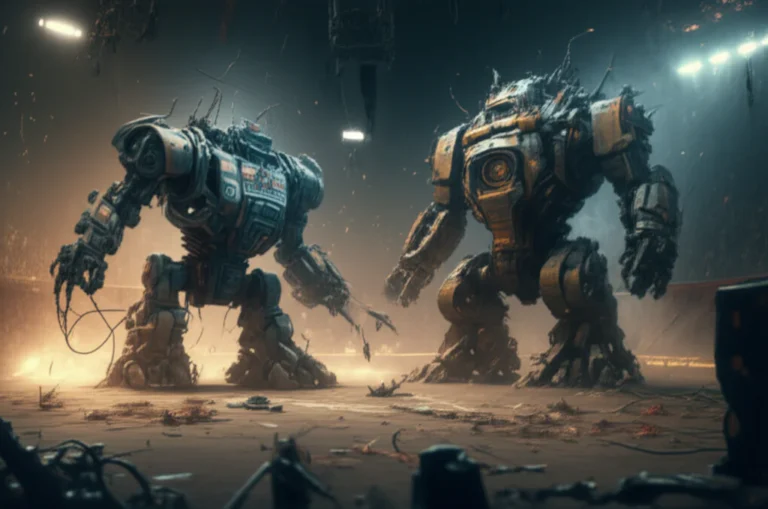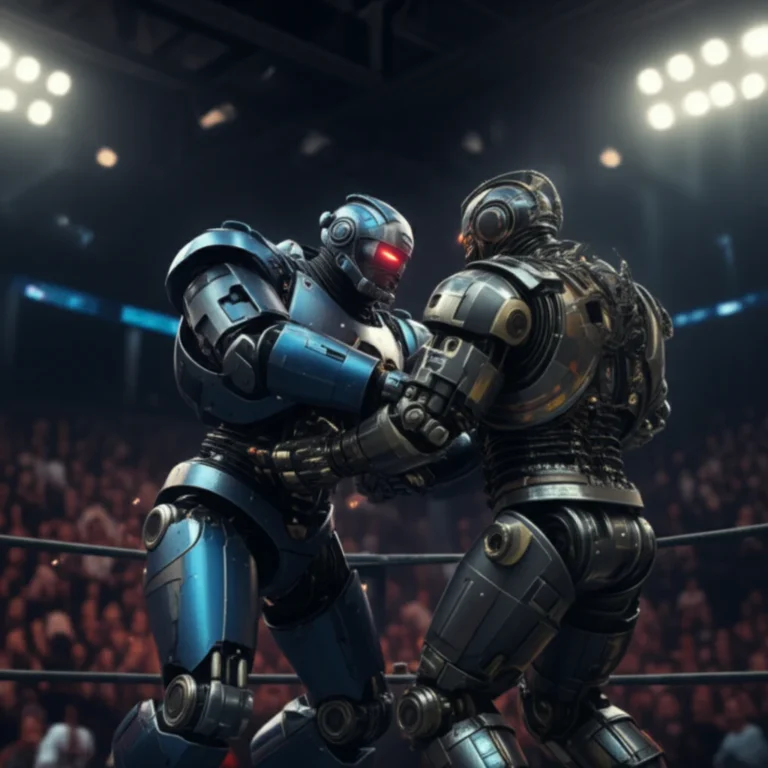Support our educational content for free when you buy through links on our site. Learn more
🤖 BattleBots Beetleweights: 10 Things You Need to Know About the Tiny Titans of Robot Combat!
You’ve seen the massive, metal behemoths of BattleBots, but have you ever wondered about the tiny titans that pack a punch in the Beetleweight class? These 3-pound robots might be small, but they’re fierce competitors, and their battles are just as exciting as their heavyweight counterparts.
We’ve been following the world of robot combat for years, and we’ve seen firsthand the incredible skill and creativity that goes into building and battling Beetleweights. In this comprehensive guide, we’ll delve into everything you need to know about these miniature mechanical marvels, from their history and rules to their champions and the future of the class. Get ready to be amazed by the world of Beetleweight BattleBots!
Key Takeaways
- Beetleweight robots are a popular and accessible weight class in robot combat, with a weight limit of 3 pounds (1.36 kilograms).
- They are known for their agility, speed, and innovative designs, making their battles just as exciting as those of their heavyweight counterparts.
- Beetleweight competitions are held all over the world, with organizations like SPARC, RCL, and NRL fostering a vibrant and competitive community.
- Building your own Beetleweight is a rewarding experience that combines engineering, creativity, and competition.
👉 CHECK PRICE on:
- Brushless Motors: Amazon | Walmart
- Speed Controllers: Amazon | Walmart
- LiPo Batteries: Amazon | Walmart | HobbyKing Official Website
- Radio Control Systems: Amazon | Walmart
- Aluminum Sheets: Amazon | Walmart | Home Depot
- Titanium Sheets: Amazon | Online Metals Official Website
- Polycarbonate Sheets: Amazon | Walmart | Home Depot
Table of Contents
- Quick Tips and Facts
- The Rise of the Beetleweights: A History of Tiny Titans
- Beetleweight BattleBots: The Rules of the Game
- Beetleweight Champions: Legends of the Tiny Arena
- Building Your Own Beetleweight: A Guide for Aspiring Robot Warriors
- Beyond BattleBots: The World of Beetleweight Robotics
- Beetleweight vs. Other Weight Classes: A Comparison
- The Future of Beetleweights: What’s Next for Tiny Titans?
- Conclusion
- Recommended Links
- FAQ
- Reference Links
Quick Tips and Facts
Want to jump into the thrilling world of robot combat? The Beetleweight class is your ticket to adrenaline-pumping action in a compact, accessible format! 💥 Here’s a quick rundown:
- Weight Limit: 3 pounds (1.36 kilograms) – That’s about the size of a hefty chihuahua! 🐶
- Accessibility: Considered the “gateway drug” of robot combat, Beetleweights are relatively affordable and easier to build than their heavier counterparts.
- Popularity: Boasting a vibrant community worldwide, Beetleweight competitions are plentiful, both within and outside of the renowned BattleBots arena.
- UK Variation: Across the pond, Beetleweights tip the scales at 1.5kg (3.3 lbs), giving UK bots a slight edge in weight.
Intrigued? You should be! Read on to discover everything you ever wanted to know about Beetleweights! 🤖💥
The Rise of the Beetleweights: A History of Tiny Titans

While the Heavyweight robots of Robot Wars and BattleBots often steal the show with their brute force and destructive power, the Beetleweight class has carved its own unique path in the history of robot combat. Let’s delve into the origins of these miniature mechanical marvels:
The Early Days: A Sub-Light Revolution
Beetleweights, along with other “Sub-Light” weight classes like Antweights (1lb) and Hobbyweights (12lbs), emerged in the early 2000s as a response to the growing cost and complexity of heavier robots. These smaller weight classes provided a more accessible entry point for builders, especially those with limited resources or experience.
BattleBots Debut: The 2004 NPC Charity Open
The Beetleweight class made its official BattleBots debut at the 2004 NPC Charity Open, a non-televised event that showcased a variety of weight classes. This marked the first and, as of now, only time Beetleweights have graced the official BattleBots arena.
One Fierce Upper-Cut: A Champion is Crowned
The 2004 NPC Charity Open saw the crowning of the first (and currently only) official BattleBots Beetleweight champion: One Fierce Upper-Cut, a formidable machine built by Fierce Robots. This victory cemented One Fierce Upper-Cut’s place in robot combat history.
Beyond BattleBots: A Global Phenomenon
While Beetleweights have yet to make a return to the televised BattleBots arena, their popularity has exploded worldwide. Numerous organizations and events dedicated to Beetleweight combat have sprung up, fostering a vibrant and competitive community of builders and enthusiasts.
A Legacy of Innovation and Accessibility
The Beetleweight class has proven that you don’t need a massive budget or years of experience to build a competitive robot. These tiny titans embody the spirit of innovation and accessibility, inspiring countless individuals to enter the exciting world of robot combat.
Want to learn more about the design and construction of Beetleweights? Check out our Robot Design category for in-depth articles and tutorials!
Beetleweight BattleBots: The Rules of the Game
Every robot combat competition has its own set of rules and regulations, and Beetleweight BattleBots is no exception. Here’s a breakdown of the key rules that govern these miniature mechanical gladiators:
Weight Limit: 3 Pounds of Fury
The defining characteristic of the Beetleweight class is its strict 3-pound weight limit. Every component of the robot, from its chassis and armor to its weapons and electronics, must fit within this weight constraint. This limitation forces builders to be creative and resourceful, maximizing their robot’s potential within a tight weight budget.
Size Restrictions: Keeping it Compact
In addition to weight, Beetleweights are also subject to size restrictions. The maximum allowable dimensions for a Beetleweight robot are 12 inches in length, 12 inches in width, and 12 inches in height. These restrictions ensure a level playing field and prevent robots from becoming too large or unwieldy.
Weapon Systems: A Variety of Arsenal
Beetleweights are allowed to utilize a wide range of weapon systems, including:
- Spinners: High-speed rotating weapons designed to deliver devastating blows to opponents.
- Flippers: Pneumatic or hydraulically powered arms that can flip opponents over, rendering them immobile.
- Hammers: Powerful impact weapons that can crush or disable opponents.
- Wedges: Simple yet effective wedges that can be used to get underneath opponents and control the battle.
Safety Regulations: Protecting Bots and Builders
Safety is paramount in robot combat, and Beetleweight BattleBots has strict safety regulations in place to protect both the robots and the builders. These regulations include:
- Fail-safes: All robots must have a fail-safe system that will disable the robot’s weapon systems in the event of a loss of control.
- Battery Requirements: Batteries must meet specific safety standards and be properly secured within the robot.
- Weapon Lockouts: Weapons must be locked out during transportation and handling to prevent accidental activation.
Judging Criteria: How Battles are Won and Lost
Beetleweight BattleBots matches are judged based on three main criteria:
- Damage: The amount of damage inflicted on the opponent.
- Aggression: The level of aggression and control displayed during the match.
- Control: The ability to control the robot and dictate the pace of the battle.
The robot that scores the highest in these three categories is declared the winner.
A Dynamic and Evolving Sport
The rules and regulations of Beetleweight BattleBots are constantly evolving as the sport grows and technology advances. This ensures that the competition remains fair, exciting, and innovative.
Interested in building your own Beetleweight? Check out our Robot Pro-Wrestling Kit to get started!
Beetleweight Champions: Legends of the Tiny Arena
The Beetleweight division, despite its relatively short history, has already produced a number of legendary champions. These miniature mechanical marvels have captivated audiences with their speed, power, and innovative designs. Let’s take a look at some of the most notable Beetleweight champions:
One Fierce Upper-Cut: The First of its Kind
As we mentioned earlier, One Fierce Upper-Cut, built by Fierce Robots, holds the distinction of being the first and only official BattleBots Beetleweight champion. Its victory at the 2004 NPC Charity Open cemented its place in robot combat history.
The International Circuit: A Global Showcase
Outside of BattleBots, the Beetleweight class has flourished on the international circuit, with numerous organizations and events crowning their own champions. Some of the most prestigious Beetleweight titles include:
- King of Bots (China): This annual competition attracts some of the best Beetleweight builders from around the world.
- RoboGames (USA): One of the largest and longest-running robot combat events in the world, RoboGames features a highly competitive Beetleweight division.
- Extreme Robots (UK): A popular UK-based robot combat organization, Extreme Robots regularly hosts Beetleweight events.
A Legacy of Innovation and Skill
The Beetleweight champions, both past and present, represent the pinnacle of engineering and combat robotics. They have pushed the boundaries of what’s possible in a 3-pound robot, inspiring countless others to enter the sport.
Want to see these Beetleweight champions in action? Check out our Event Announcements for upcoming robot combat events near you!
Building Your Own Beetleweight: A Guide for Aspiring Robot Warriors
Building a Beetleweight robot is a challenging but rewarding experience. It’s a chance to unleash your creativity, learn new skills, and compete against other passionate robot enthusiasts. Here’s a step-by-step guide to help you get started on your own Beetleweight journey:
1. Define Your Design: Form Follows Function
The first step is to define your robot’s design. What kind of weapon system do you want to use? What type of drive train will be most effective? What materials will you use for the chassis and armor? Consider your budget, available resources, and the competition you’ll be facing.
2. Gather Your Materials: The Building Blocks of Destruction
Once you have a design in mind, it’s time to gather the materials you’ll need. Some common Beetleweight components include:
- Motors: Brushless motors are a popular choice for their high power-to-weight ratio.
- Speed Controllers: Electronic speed controllers (ESCs) regulate the speed and direction of your motors.
- Batteries: Lithium polymer (LiPo) batteries are commonly used in Beetleweights for their high energy density.
- Receiver and Transmitter: A radio control system is used to control your robot.
- Chassis and Armor: Aluminum, titanium, and polycarbonate are popular choices for Beetleweight chassis and armor.
- Weapons: The type of weapon you choose will depend on your robot’s design and your fighting style.
👉 CHECK PRICE on:
- Brushless Motors: Amazon | Walmart
- Speed Controllers: Amazon | Walmart
- LiPo Batteries: Amazon | Walmart | HobbyKing Official Website
- Radio Control Systems: Amazon | Walmart
- Aluminum Sheets: Amazon | Walmart | Home Depot
- Titanium Sheets: Amazon | Online Metals Official Website
- Polycarbonate Sheets: Amazon | Walmart | Home Depot
3. Assemble Your Robot: Bringing Your Vision to Life
With your materials gathered, it’s time to start assembling your robot. This is where your design and engineering skills will be put to the test. Use a combination of hand tools and power tools to cut, drill, and fasten the components together.
4. Wire the Electronics: The Nervous System of Your Bot
Wiring the electronics can be one of the most challenging aspects of building a Beetleweight. Follow the wiring diagrams for your components carefully and use heat shrink tubing to insulate connections.
5. Program Your Robot: Giving Your Bot a Brain
If you’re using a microcontroller, you’ll need to program your robot to control its movements and weapon systems. There are a variety of programming languages and software platforms available, such as Arduino and RobotC.
6. Test and Refine: Trial and Error is Key
Once your robot is assembled and programmed, it’s time to test it out. Start with basic driving tests and then gradually increase the complexity of the tests. Don’t be afraid to make mistakes – this is all part of the learning process.
7. Compete and Have Fun: Enter the Arena
With your Beetleweight built and tested, you’re ready to enter the arena! Find a local robot combat event and put your skills to the test. Win or lose, you’ll gain valuable experience and make lasting connections in the robot combat community.
Building a Beetleweight is a journey of learning, problem-solving, and creativity. Embrace the challenge and have fun along the way!
For more in-depth articles and tutorials on robot design and construction, check out our Robot Design category. And for a behind-the-scenes look at the world of robot combat, visit our Behind the Scenes category.
Beyond BattleBots: The World of Beetleweight Robotics
While BattleBots may be the most well-known platform for robot combat, it’s just the tip of the iceberg when it comes to the world of Beetleweight robotics. These tiny titans have captured the imaginations of builders and enthusiasts worldwide, leading to a thriving global community and a diverse range of competitions.
A Global Phenomenon: Beetleweights Around the World
Beetleweight competitions are held in countries all over the world, from the United States and Canada to Europe, Asia, and Australia. Each region has its own unique rules and regulations, but the spirit of competition and innovation remains the same.
Organizations and Events: A Hub for Beetleweight Enthusiasts
Numerous organizations and events are dedicated to promoting and supporting the Beetleweight class. Some of the most notable include:
- SPARC (Standardized Procedures for the Advancement of Robot Combat): SPARC is a non-profit organization that develops and maintains standardized rules and regulations for robot combat, including the Beetleweight class.
- Robot Combat League (RCL): RCL is a professional robot combat league that features a variety of weight classes, including Beetleweights.
- National Robotics League (NRL): NRL is a student-focused robotics competition that includes a Beetleweight division.
Beyond Combat: Exploring the Versatility of Beetleweights
Beetleweight robots are not just limited to combat. Their small size and maneuverability make them ideal for a variety of other applications, such as:
- Education: Beetleweights are an excellent educational tool, teaching students about engineering, physics, and programming.
- Research: Researchers are using Beetleweights to study topics such as locomotion, artificial intelligence, and materials science.
- Hobby and Entertainment: Many people build Beetleweights simply for the enjoyment of designing, building, and operating robots.
A Growing Community: Connecting with Fellow Beetleweight Enthusiasts
The Beetleweight community is a welcoming and supportive group of individuals who share a passion for robot combat. There are numerous online forums, social media groups, and local clubs where you can connect with other Beetleweight builders, share ideas, and get help with your projects.
Whether you’re interested in building a competitive combat robot, exploring the educational potential of robotics, or simply want to have some fun with robots, the world of Beetleweight robotics has something to offer everyone.
To stay up-to-date on the latest Beetleweight news, events, and tech reviews, check out our Tech Reviews category.
Beetleweight vs. Other Weight Classes: A Comparison
Beetleweight robots are just one of many weight classes in the world of robot combat. Each weight class has its own unique characteristics, advantages, and disadvantages. Let’s compare Beetleweights to some of the other popular weight classes:
Antweight: The Tiny Titans
- Weight Limit: 1 pound (0.45 kilograms)
- Advantages: Extremely affordable and easy to build, making them ideal for beginners. Highly maneuverable and can pack a surprising punch for their size.
- Disadvantages: Very fragile and susceptible to damage. Limited weapon options due to their small size.
Hobbyweight: The Stepping Stone
- Weight Limit: 12 pounds (5.44 kilograms)
- Advantages: A good balance between affordability and performance. More weapon options than Antweights and can withstand more punishment.
- Disadvantages: Can be more expensive to build than Antweights and Beetleweights. Still relatively fragile compared to heavier weight classes.
Featherweight: The Agile Contenders
- Weight Limit: 30 pounds (13.6 kilograms)
- Advantages: More powerful and durable than the lighter weight classes. A wide variety of weapon options available.
- Disadvantages: Can be significantly more expensive to build than the lighter weight classes. Requires more advanced engineering skills.
Heavyweight: The Kings of Destruction
- Weight Limit: 250 pounds (113.4 kilograms)
- Advantages: The most powerful and destructive robots in combat. Can deliver incredible amounts of force.
- Disadvantages: Extremely expensive to build and maintain. Requires a high level of engineering expertise.
Beetleweights: The Sweet Spot
Beetleweights occupy a sweet spot in the robot combat world. They offer a great balance of affordability, performance, and accessibility. They’re not as fragile as Antweights, but they’re also not as expensive or complex as the heavier weight classes. This makes them an ideal choice for both beginners and experienced builders alike.
Here’s a table summarizing the key differences between the weight classes:
| Weight Class | Weight Limit (lbs) | Advantages | Disadvantages |
|---|---|---|---|
| Antweight | 1 | Affordable, easy to build, highly maneuverable | Fragile, limited weapon options |
| Beetleweight | 3 | Affordable, good performance, accessible | Still relatively fragile compared to heavier classes |
| Hobbyweight | 12 | Good balance of affordability and performance, more weapon options | Can be more expensive to build than Antweights and Beetleweights |
| Featherweight | 30 | More powerful and durable, wide variety of weapon options | Can be significantly more expensive to build, requires more advanced engineering skills |
| Heavyweight | 250 | Most powerful and destructive, can deliver incredible amounts of force | Extremely expensive to build and maintain, requires a high level of engineering expertise |
Ultimately, the best weight class for you will depend on your budget, experience, and goals. If you’re just starting out, Beetleweights are an excellent choice. They’ll give you a taste of the excitement of robot combat without breaking the bank.
The Future of Beetleweights: What’s Next for Tiny Titans?
The Beetleweight class has come a long way since its humble beginnings. From a small, niche hobby to a global phenomenon, these tiny titans have captured the hearts and minds of robot enthusiasts worldwide. But what does the future hold for Beetleweights? Here are a few trends and predictions:
Continued Growth and Innovation: Pushing the Limits of 3 Pounds
The Beetleweight class is constantly evolving as builders find new and creative ways to push the limits of what’s possible in a 3-pound robot. We can expect to see even more innovative designs, powerful weapons, and advanced electronics in the years to come.
Increased Accessibility: Making Robot Combat More Affordable
As technology advances and manufacturing costs decrease, Beetleweight robots are becoming more affordable than ever before. This increased accessibility is opening up the sport to a wider audience, including students, hobbyists, and makers.
A Return to BattleBots? A Dream for Many Beetleweight Enthusiasts
Many Beetleweight enthusiasts are hoping to see the class make a return to the televised BattleBots arena. The popularity of the class and the excitement of Beetleweight combat would make for a compelling addition to the show.
The Rise of 3D Printing: Revolutionizing Beetleweight Design
3D printing is revolutionizing the way Beetleweight robots are designed and built. Builders can now create complex and intricate parts that were previously impossible to manufacture using traditional methods. This is leading to a new era of Beetleweight design, with robots that are lighter, stronger, and more agile than ever before.
A Global Community: Connecting Beetleweight Enthusiasts Worldwide
The internet and social media have made it easier than ever for Beetleweight enthusiasts to connect with each other, share ideas, and collaborate on projects. This global community is fostering a spirit of innovation and collaboration, pushing the boundaries of Beetleweight robotics.
The future of Beetleweights is bright. With continued growth, innovation, and accessibility, these tiny titans are poised to become an even bigger part of the world of robot combat.
What are your predictions for the future of Beetleweights? Share your thoughts and ideas in the comments below! And be sure to check out our Opinion Pieces category for more insights and perspectives on the world of robot combat.
Conclusion

From their humble beginnings to their global popularity, Beetleweights have proven that size doesn’t matter when it comes to robot combat. These tiny titans offer a thrilling blend of affordability, accessibility, and innovation, making them an ideal entry point for anyone interested in the world of robot combat. Whether you’re a seasoned builder or just starting out, Beetleweights provide a platform for creativity, competition, and endless possibilities. So, what are you waiting for? Join the Beetleweight revolution and experience the excitement of these miniature mechanical marvels!
Recommended Links
👉 Shop Beetleweight Robot Parts on:
- Brushless Motors: Amazon | Walmart
- Speed Controllers: Amazon | Walmart
- LiPo Batteries: Amazon | Walmart | HobbyKing Official Website
- Radio Control Systems: Amazon | Walmart
- Aluminum Sheets: Amazon | Walmart | Home Depot
- Titanium Sheets: Amazon | Online Metals Official Website
- Polycarbonate Sheets: Amazon | Walmart | Home Depot
Recommended Books on Robot Combat:
- Robot Wars: The Official Guide: Amazon
- BattleBots: The Official Guide: Amazon
- Robot Combat: The Ultimate Guide: Amazon
FAQ

What are the weights of BattleBots?
BattleBots has a variety of weight classes, each with its own unique set of rules and regulations. Here’s a breakdown of the current weight classes:
- Antweight: 1 pound (0.45 kilograms)
- Beetleweight: 3 pounds (1.36 kilograms)
- Hobbyweight: 12 pounds (5.44 kilograms)
- Featherweight: 30 pounds (13.6 kilograms)
- Lightweight: 60 pounds (27.2 kilograms)
- Middleweight: 120 pounds (54.4 kilograms)
- Heavyweight: 250 pounds (113.4 kilograms)
Why are there different weight classes?
Different weight classes allow for a more diverse range of robots and combat styles. Lighter weight classes are more affordable and accessible, while heavier weight classes offer more power and destructive potential.
Read more about “BattleBots Champions by Year …”
How much does the Minotaur weight in BattleBots?
Minotaur, a formidable robot known for its powerful spinning weapon, competes in the Heavyweight class, which has a weight limit of 250 pounds.
Read more about “Who Won BattleBots Season 12? … 🏆”
How much does the Glitch weight in BattleBots?
Glitch, a highly mobile robot with a unique “flipping” weapon, also competes in the Heavyweight class, with a weight limit of 250 pounds.
What is banned in BattleBots?
BattleBots has a strict set of rules and regulations to ensure the safety of the robots, builders, and spectators. Some of the items that are banned in BattleBots include:
- Flamethrowers: These weapons pose a significant fire hazard and are prohibited for safety reasons.
- Explosives: Explosives are also banned for safety reasons.
- Toxic or Corrosive Substances: Substances that could harm the robots, builders, or spectators are prohibited.
- Weapons of Mass Destruction: Weapons that could cause widespread damage or harm are strictly forbidden.
Why are these items banned?
These items are banned to ensure the safety of the robots, builders, and spectators. The goal of BattleBots is to provide a safe and exciting environment for robot combat.
Read more about “… Robot Wrestling Championship: 10 Things You Need To Know 🤖”
Reference Links
- BattleBots: BattleBots Official Website
- Fierce Robots: Fierce Robots Official Website
- HobbyKing: HobbyKing Official Website
- Online Metals: Online Metals Official Website
- BattleBots – Wikipedia: BattleBots – Wikipedia
- Robot Wars: Robot Wars Official Website
- SPARC: SPARC Official Website
- Robot Combat League: Robot Combat League Official Website
- National Robotics League: National Robotics League Official Website
- King of Bots: King of Bots Official Website
- RoboGames: RoboGames Official Website
- Extreme Robots: Extreme Robots Official Website





